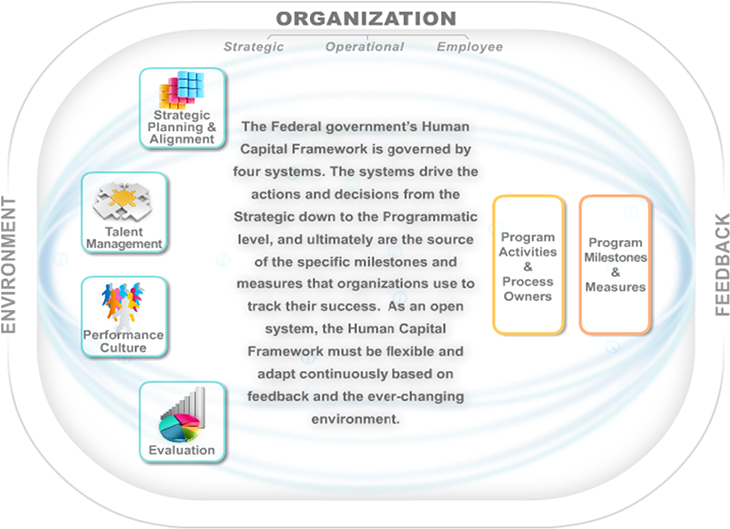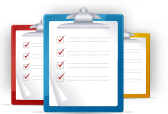Human Capital Framework
Overview
The Office of Personnel Management (OPM) Human Capital Framework (HCF) provides comprehensive guidance on strategic human capital management in the Federal Government. The framework provides direction on human capital planning, implementation, and evaluation in the Federal environment. The HCF's flexible structure supports organizational agility and adaptability, which agencies need in order to function successfully in the 21st century's dynamic environment.
The HCF guides agencies to effectively manage an organization's talent by promoting the use of sound talent management practices. The Framework provides talent management strategies that support and shape an organization's current workforce, while preparing for the future. It provides guidance on evaluation techniques that measure progress and outcomes for program and policy effectiveness, and prepares organizations for change by providing a foundation for organizational agility.
For more information, please contact us at humancapital@opm.gov.
Related Information
Take the Human Capital Framework Assessment
Does your agency hit the target when it comes to strategic human capital planning? Start
Human Capital Framework Structure
The Structure of the Human Capital Framework (HCF)
The Human Capital Framework (HCF) incorporates insights from strategic human capital management, organizational development and complexity science to provide senior leaders, supervisors, HR practitioners, and employees with practical guidance and insights on how to align with their agency's mission, goals, and program objectives — even in the midst of constant change.
HCF is organized across four open systems:
Within each of these systems, a series of focus areas has been defined. These focus areas are not requirements or milestones, nor are they an exhaustive list. They provide the key elements to consider when designing and implementing each of the systems.
The Framework has broad applicability across multiple organizational perspectives, but the functional implications vary based on the role each employee plays in an agency's management of its human capital. The Human Capital Framework presents each system from three perspectives, each representing a different level of responsibility within an organization.
- Strategic View: Senior Leadership, Advisors, Managers
- Operational View: HR Practitioners, Program Supervisors
- Employee View: Team Leaders, Line Employees
A defining characteristic of the HCF is that no component exists in isolation. From senior leadership to line employees — every person, every office, every agency is one part of an interconnected whole. While it is certainly true that not all employees of the Federal Government interact directly with each other, and it is also true that the actions of one person or organization can potentially have a significant and lasting impact across the entire workforce. This is because the government, just like any other group comprised of individuals, is a complex adaptive system, which is to say it is affected constantly and continuously by both internal and external environmental factors.

The Human Capital Framework has an open system recognizes that agencies must be flexible and adapt continuously based on feedback loops in the ever-changing environment. This Framework presents each system from three perspectives, each representing a different level of responsibility within an organization - Strategic View: Senior Leadership (Advisers, Managers) Operational View (HR Practitioners, Program Supervisors) and Employee View (Team Leaders, Line Employees).
The four systems that structure the Human Capital Framework - Strategic Planning and Alignment (plan), Talent Management (implement), Performance Culture (implement), and Evaluation (evaluate)- drive the agency’s actions and decisions from overall mission to individual programs. The systems follow the Human Capital Lifecycle of plan, implement, evaluate. The alignment between mission and workforce drives the specific milestones and measures that organizations use to track their performance in Human Capital Management.
Complex Adaptive Systems
Organizational agility has become and will continue to be a requirement for Federal organizations as external environmental factors (e.g., budget fluctuations, changes in public expectations, unforeseen crises) become more complex and unpredictable. This continuous change requires that modern organizations acquire a flexible and responsive approach to managing talent in order to achieve their missions.
Reflective of this new understanding of complexity and rapid change, organizational scholars have begun applying complexity science to better understand how best to manage human resources toward organizational outcomes. Complexity science views organizations as non-linear, open systems where a network of actors cluster toward shared objectives. These clusters are temporary and contingent, aligning and realigning as actors respond to changes in the external and internal environment. The nodes in this network are key drivers of organizational outcomes and reflect informal as well as formal focal points of resources, insights, influence, and activities.
The lens of complexity science provides a new conceptualization of organizations as self-organizing systems. This new understanding of organizations implies an equivalent new role for Human Resources Management. In complex adaptive systems, HR's job is to influence the emergent behaviors of leaders, managers, and employees as they respond to their environment. HR must encourage the behaviors that will achieve organizational goals, while also enabling constant reinvention of the organization as needed to address internal and external environmental changes. HR itself must constantly flex policies and processes to align with emerging organizational needs.
Federal agencies have a long tradition of organizational structures with firm boundaries (established by organizational charts) and strict internal and external areas of formal authority (statutes, regulations, executive orders, policies, interagency working agreements, etc.). Increasingly, however, agencies are recognizing that they, too, exist in a complex adaptive system. Agencies have permeable boundaries that are impacted daily by external factors (i.e., budgets, social media, unexpected crises), which in turn affect how agencies achieve their missions.
Agencies must now build capacity to manage change, while pursuing optimal performance and mission accomplishment. To accomplish this, agencies must be agile and responsive with how they manage their organization and human resources. Managing with agility incorporates the notion of being flexible and open to adopting new business processes, while adapting an organization's mindset and culture to constant change. Agencies must enable leaders, managers, and employees to align toward outcomes, while constantly scanning for projected changes and preparing to adapt to new requirements and expectations.
Related Information
A Few Foundational Elements
Executive agencies are organized based on their missions, authorities, programs, and budgets.
Agencies are required to establish strategic goals that are publicly available and reflect the direction provided by the President and Congress through policy and budget decisions.
Supporting Governance
- 5 CFR Part 250 – Personnel Management in Agencies
- The President
-
Sets the Administration's agenda with a vision, an agenda, and budgetary proposals. The President exercises oversight through regular reviews of agency performance.
- Congress
- Congress authorizes policies and programs, and the budgetary resources needed to execute them. Congress also exercises oversight responsibilities for policy and program outcomes, and the resources expended to achieve outcomes.
- Chief Human Capital Officers (CHCO) Act of 2002
Title XIII – Federal Workforce Improvement Subtitle A – Chief Human Capital Officers -
A law requiring 24 Executive Departments and Agencies to appoint or designate a Chief Human Capital Officer and establish a CHCO Council to bring the management of Human Capital to a higher level of attention and authority. The Act, in part, dictates the following:
The functions of each Chief Human Capital Officer shall include setting the workforce development strategy of the agency;
- Assessing workforce characteristics and future needs based on the agency's mission and strategic plan;
- Aligning the agency's human resources policies and programs with organization mission, strategic goals, and performance outcomes;
- Developing and advocating a culture of continuous learning to attract and retain employees with superior abilities;
- Identifying best practices and benchmarking studies; and
- Applying methods for measuring intellectual capital and identifying links of that capital to organizational performance and growth.
- GPRA Modernization Act (GPRAMA) of 2010
-
A law that modernizes the Government Performance and Results Act of 1993, requiring quarterly performance assessments of government programs to monitor and assess each agency's performance and improvement, as well as directing the establishment of Performance Improvement Officers and a Performance Improvement Council led by the Office of Management and Budget (OMB).
GPRAMA, in part, dictates that OMB collaborates with agencies to develop a Federal Government Performance Plan for each agency containing priority goals of two types: outcome and management improvement goals. Agencies are required to integrate Human Capital Strategies into their agency strategic plans in order to assure full alignment of talent with agency mission and strategy. Agencies must have quarterly targets with clearly defined milestones, and report quarterly on a public website. In addition, agencies must report on and update their priority goals every two years.
- Office of Management and Budget (OMB)
-
Serves the President in implementing his vision across the Executive Branch through coordination of budget management and oversight.
- Office of Personnel Management (OPM)
-
Regulates the laws governing human capital management to build a high quality and diverse Federal workforce. OPM delegates personnel authorities to the agencies and monitors their compliance and effectiveness.
- Government Accountability Office (GAO)
-
Serves Congress as an independent, nonpartisan agency to help improve agency performance. GAO's mission is to investigate how the Federal Government uses tax dollars that have been allocated, and to report on their findings.
Human Capital Business Process
Each section of the HCF Resource Guide provides an overview of a system, its associated focus areas, and its relationship with the other systems. It also examines the system using a five step business process matrix applied to each of the three views (strategic, operational, employee levels).
A Human Capital Business Process outlines the activities of planning, implementing, assessing, informing, and improving the critical elements of the HCF that ultimately drive performance and outcomes in each system. The intent of the Human Capital Business Process is to provide a systematic way to develop, track, report, and improve specific goals, objectives, and action items as they relate to the agency HR initiatives.
The business process is particularly important within complex adaptive systems. Given the self-organizing clusters of activity toward agency goals, it is process more than policy that influences emergent behaviors. Human Resources Management must shape and implement appropriate processes at the level of leaders, managers, and employees in order to assure organizational mission accomplishment.
| Human Capital Business Process | ||||
|---|---|---|---|---|
PlanAlign strategic human capital initiatives, goals, and objectives with the agency's strategic plan and GPRA goals |
ImplementHR and hiring/ program managers collaborate to implement and achieve Human Capital and programmatic results |
EvaluateUse business analytics to measure strategic and operational Human Capital-related measures |
InformCapture critical Human Capital measures, report assessment results to agency leadership, and use analysis of results to drive change |
ImproveAdjust and enhance Human Capital strategies and practices based on data driven decisions |
Human Resources Information Technology (HRIT)
This framework does not specify which technologies agencies need to use to implement the HCF. However, ensuring that employees' employment experience with the Federal Government provides an optimal environment for ensuring a seamless and efficient process from "resume to retirement", the following Human Resources Information Technology (HRIT) principles should be adhered to:
- Support the HCF wholly or in part. In choosing an HRIT system, agencies need to pick systems that will support at least one Focus Area of the HCF. Of course, the more Focus Areas supported, the better.
- Be able to share information and processes. Thus, when a job applicant fills out a form, that information should be available for reuse in other applications.
- Be auditable. To support the Evaluation System of the HCF, agency HRIT systems need to share their data with OPM for reporting and benchmarking purposes. When possible, HRIT system data should be automated and available through data feeds. This will be beneficial to both OPM and the agencies as it eliminates the need for data calls and manual reporting.
Whenever possible, agencies should share their best practices in selecting, implementing, and operating HRIT systems. HRIT is an essential part of the success of the HCF, and all agencies can benefit from the experiences and expertise of their fellow agencies.








